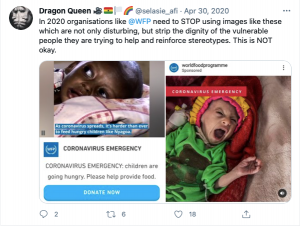A Debatable Use of Photographs

Lau Sean Hui Lok
The pandemic brings a ‘new normal’ to the world. For non-profits, it may be a more difficult time to receive funding from the public through large-scale events. Thus, digital platforms now play a more important role for organizations to execute their campaigns. While some NGOs like the Arreles Foundation successfully launched the ‘Homeless Fonts’ campaign, which received massive support and donations from the netizens (Arreles Foundation,2020), some did the opposite. The World Food Program (WFP) demonstrated what could go wrong with a fundraising campaign.

The fundraising campaign launched in May 2020 featured photos of children from less developed countries who are receiving aid from WFP. The two photographs that went viral on social media depicted a screaming child during care and another one salivating. Mixed comments were generated about the situation, with most of them lie on the downside. Comments like “Wtf that photo is beyond frightening thought this was for a horror film or something.” and “You make me sick spreading picture like this to get people to give…” were posted on the Facebook post (Chadwick, 2020). WFP, however, did not pull the photographs down immediately but claimed that it demonstrates how people can have divergent perceptions about the same incident. Although they eventually decided to withdraw the images and made a statement on the choice of campaign photographs, it still stirred up negative discussions on the internet.

In fact, the strategy used in this fundraising campaign may be unethical. On one hand, the photographs use the beneficiaries as their subject, which may exploit their rights as consent have not been sought. This is a common mistake in marketing strategies when terms of photograph usage are not well-drafted. It redirects the focus to the person in the image instead of the product or service, which inserted various level of unethical perceptions on the individual. On the other hand, the photos might make its viewers uncomfortable.
The choice of photograph was arguably of bad taste: When photos involved controversial or inhumane situations, they should only be displayed with caution. For instance, the photograph of a 3-year-old Syrian kid on the beach in 2015 aroused massive awareness of the refugee’s problem rather than causing controversies (The Guardian, 2015). Photographs often serve a larger impact than words, therefore it could play a critical role in determining a campaign’s success.
During the pandemic, companies struggle to raise funds for their target audience. However, the inappropriate use of marketing strategies will not only bring adverse impact but also affect the reputation and credibility of the organization. For non-profit organizations who serve as role models to engage in benefactions, they should pay more attention to every move. Nevertheless, there are often crisis involving NGO’s unethical behaviors. Thus, it is crucial to plan thoroughly before publishing or executing any plans.
After all, campaigns are meant to benefit the underprivileged, but not creating unwanted attention from the public.
Reference
Chadwick, V. (2020, May 27). World food Programme Pulls COVID-19 fundraising images after backlash. Retrieved March 14, 2021, from https://www.devex.com/news/world-food-programme-pulls-covid-19-fundraising-images-after-backlash-97330
Fundation, A. (n.d.). Homelessfonts.org. Retrieved March 14, 2021, from https://www.homelessfonts.org/
Shocking images of drowned Syrian BOY Show Tragic plight of refugees. (2015, September 02). Retrieved March 15, 2021, from https://www.theguardian.com/world/2015/sep/02/shocking-image-of-drowned-syrian-boy-shows-tragic-plight-of-refugees
